One of the hardest truths to overcome when acquiring users or leads for your business is the work you're doing today will start to yield worse results at some point in the future.
Near all of the channels, you prioritize to acquire leads or users will run into challenges at some point. Maybe there is only so much money you can invest in paid channels before your LTV: CAC starts to look unhealthy, or more of your competitors start to invest their budget into content marketing saturating the space and decreasing the number of visits your content attracts.
For marketers this can feel a lot like getting punched in the face slowly, you know the pain is coming, but you just close your eyes and hope for the best.
 The Marketer never stood a chance!
The Marketer never stood a chance!
However, there is something you can do about it. In a previous post on creating an acquisition strategy, I talked about keeping track of the growth potential of each channel you're currently focused on.
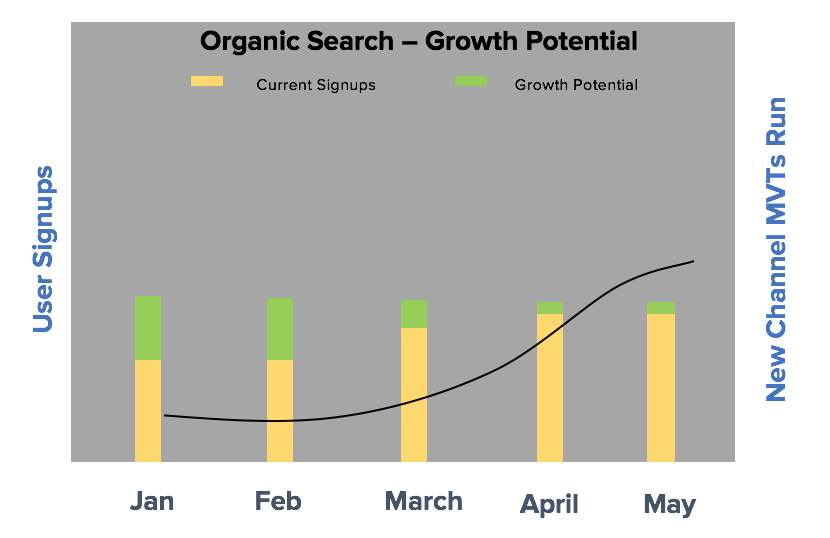
In the chart above I'm looking at the growth of user signups to a free product from organic search. Overtime as we acquire more sign ups from that channel, my growth potential continues to diminish. If this is one of the two channels I'm reliant on for user growth, as that potential starts to be eroded, I need to allocate some of my time to finding new potential channels for growth.
How do I run experiments to find new channels for acquisition?
It's a lot easier to create experiments for everything post signup. Running tests in the user signup flow, as part of the onboarding, or to improve retention tends to be a little cleaner. However, it's still possible to have a test framework for acquisition that allows you to maximize your time, effort and results.

Your approach is similar to how you would run experiments for any other part of the funnel. You start with a clear goal, go through an ideation stage with some type of model for prioritizing tests around those ideas. Don't obsess too much about how you choose to prioritize those ideas, frameworks like PIE and ICE are very similar and how you end up scoring your ideas will still be pretty subjective. Once an experiment is successful you'll look to scale that channel and create a chart to track its growth potential (like the one above).
1. Can Zapier acquire more users through YouTube?
Let's go through a couple of examples of how this would work in action. We'll first use Zapier. A lot of their traffic comes from search.
 Image from SimilarWeb
Image from SimilarWeb
The reason Zapier get so much search traffic is they provide extremely helpful guides to help you choose the best software and apps. For example this guide on dictation software or this list of the best to do apps (Todoist is a personal favorite of mine). People are searching on Google for this information.
As an acquisition marketer who is looking for new channels for growth, I would take that information and identify other places people may be looking for this information. To help, I could survey Zapier's free users using a tool like TypeForm or SurveyMonkey. Using that information and my own research I would have a list of other channels where I could run some MVT's (minimal viable tests).
An example of one channel I would have high up that list is YouTube. As a channel it's still growing, over 1 billion hours of video is consumed on YouTube per day ....... YES .... that's 1 billion <- insert mind blown gif right here. However, it's not the ideal channel for every business and that's evident in the fact only 9% of US small businesses have a presence there.
Step 1: Doing some initial research to determine if it's worth running a test on YouTube.
The first thing you want to do with any new channels is some initial research to validate if it's worth dedicating both time and resources to running an MVT for that channel.
Without going through everything Zapier could do, here is some information they can pull real quick:
a. Popular Blog Posts
The first thing I would look at is the most popular blog posts they've created. Zapier has two types of blog posts that I feel could be a fit for Youtube:
Posts that list the best apps for a certain category:
- A post that lists the top apps to manage your schedule
- A post that lists the best To Do apps (as noted above)
- A post that lists the best Pomodoro apps, this is how I do focused work.
Posts that provide a complete guide on how to use a certain app:
- A post that teaches you everything you need to know about Google sheets (it's an awesome guide)
- A post that teaches you everything you need to know about Google forms
I would then search for these topics on Youtube to see if there is search volume for them, for example, looking to see what volume exists for 'google sheets tutorials':

b. Analyzing Competitor Channels
Don't think of these as competitors in the sense they're selling a similar product to you, instead, these are people who create the type of content your audience will be interested in.
Just search for some keywords relevant to the content you want to produce, use head keywords when searching on Youtube.
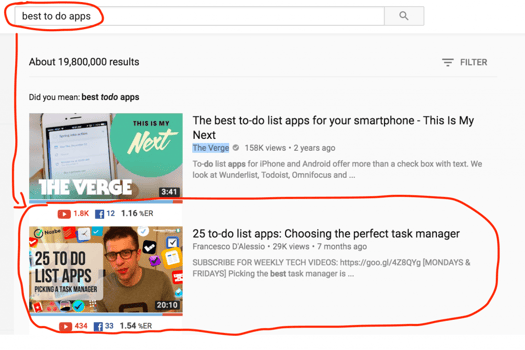
You can then go to channels you've found that create content you want to appear for and sort through their most popular videos. We'll also use this information later as part of the MVT we want to run.

Step 2: Doing some research to understand how the channel works
What separates the best acquisition marketers from everyone else is both their ability and determination to figure out the mechanics of how a certain channel works.
When you're looking to identify new potential growth channels and preparing to run some experiments in these, you need to have some understanding of how the channel works.
For example, when deciding on how to run an MVT for Youtube I would at least need to understand how videos are ranked, with the most important factors being:
- Audience Retention: How much of your video is actually watched?
- Total Watch Time: The total amount of time people spend watching your videos. Google tends to favor this metric because it's a true measure of how valuable your videos are. You could have a 100% retention rate of a 2-minute video or a 50% retention rate on a 15-minute video. In this example, the second video is getting you a better watch time.
- Engagement: All of the engagement metrics you would expect Google to measure: Likes, Comments, Shares, Subscribers, how many times your video is added to a playlist.
- Keyword Optimization: Your video's title, tags, description etc.
A word of warning, doing in depth research on Youtube can lead you down some weird and wonderful paths before you know it, a year has gone by and you can't remember any of the videos you've watched :/
 Some people never make it back from Youtube
Some people never make it back from Youtube
Step 3: Deciding on the goal of your MVT
Now you're ready to decide on the goals of your MVT. At this point we've done a lot of research, we're happy the channel has potential and we understand how the channel works.
In this case, my goals are straightforward:
- If publishing video content, show I can generate views for content relevant to my audience.
- Show I can turn those views into user sign ups for Zapier
"Wait, of course, you're going to be publishing video content!"
Well, just read the next point to find out more :)
Step 4: Prioritize your ideas for the MVT
The next thing you want to list out is your ideas for how to run the MVT. From my experience, in a lot of cases, figuring out how minimal your minimal viable test should be to properly test a channel can be a real challenge.
Take the decision we have to make for Zapier's test. Given what we know about Youtube if we produce 3 to 5 to 8 videos to test the channel if they don't perform, can we definitely say it's not a viable channel, or we just didn't create enough content to build up enough watch time etc?
The ideas I would consider for this test would be:
- Swing Big: At times your MVT requires real investment, you need to swing big. You have to be prepared to be wrong. The best marketers I know are ok with being wrong.
I would invest for 3 to 4 months, maybe posting 2 videos per week using the research we collected above to select topics that we know had search volume.
After that 3 to 4 months I would look at both the video views we accumulated and my ability to turn those views into additional user sign ups.
- Get Fast Feedback: Of course, there are often ways to shorten your feedback cycle. In this case, our research above showed there are already successful channel owners who produce the kind of videos that would appeal to Zapier's audience. We could simply pay some of these channel owners to create a video about some of Zapier's most popular integrations.
- Collaborate with Influencers: A version of the above idea is to collaborate with influencers to do a guest review on Zapier's channel and promote that video to both audiences.
There is an endless number of ideas as part of this test, simply prioritize them and start running through them in order.
Step 5: Decide if you should scale the channel or look for other growth opportunities
At the end of the time allocated for the test, you need to decide if you want to invest resources/budget/time into scaling the channel or continue looking for new areas of growth.
If the channel doesn't look promising, make the decision to move on, there is nothing worse than investing a lot into a channel only for it to produce minuscule results.
You can apply each of those steps to the simple framework we introduced at the start of this post.
 Zapier MVT Experiment Framework
Zapier MVT Experiment Framework
It's fun, right? Let's go through one more quick example using another product I love ... Zoom.
2. Can Zoom acquire more users through freelancers?
Zoom provides video technology for meetings, it's a great product. You can see that from where they acquire traffic.

Most of that search traffic is for branded keywords. They have a product that helps to promote itself via usage. I promote their product continually through the video calls I have using Zoom. Once people experience the product, they'll usually go check it out for themselves.
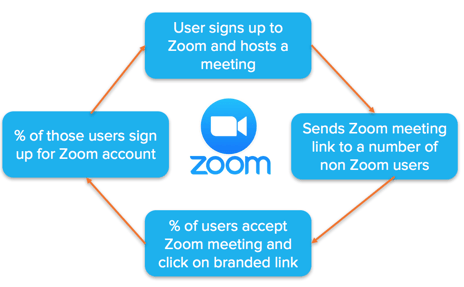 How the Zoom product refers users.
How the Zoom product refers users.
There are currently over 700k companies using Zoom.
One channel I would test is a referral model focused on freelancers/consultants. The program would provide them with some extra perks for using Zoom as their primary communication tool and helping to refer other companies to the product. The reason being, I suspect a lot of people from those groups spend a bunch of their time doing video calls with clients and work colleagues.
The purpose of the program would be to help Zoom land and expand with new companies. Get companies using the product via calls with their freelancers.
Ok, we need to take a quick interlude because I just did some research and found something, Zoom already has a referral program, I should sign up :).
Zoom's current referral program isn't identical to what I'm pitching, so I'll run through the steps anyway.
Step 1: Doing some initial research to determine if it's worth running a test around a referral program for freelancers.
The initial research for this MVT is going to be a little more complicated than what we could do for Youtube.
The first thing I would want to do is identify these people within the signup flow. Zoom's current signup flow is pretty straight forward, asking people to create an account and then invite colleagues to join them.
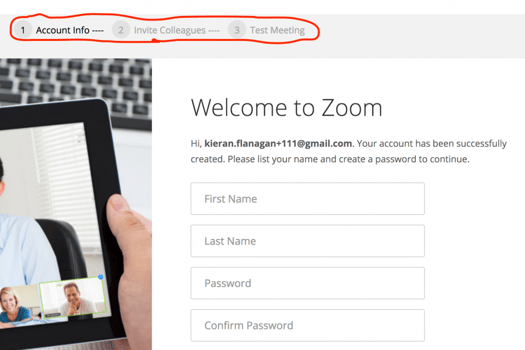
I would need to add an additional step to this flow that asked some additional questions to bucket users into groups so people can identify themselves as freelancers/consultants. The danger with doing that is you decrease the conversion rate.
From running a number of tests in HubSpot's free product signup flow, the drop off in conversion rate due to additional questions has been minimal and in most cases, it caused no real change. I would be pretty hopeful this change wouldn't impact the conversion rate much.
Once I had that information I could bucket those users into groups to survey the freelancers/consultants. I can also arrange some calls. For freelancers I'm interested in the type of clients they work with, who arranges the video calls, can the freelancer suggest the software they use on those calls, and how many of their clients typically use video software that isn't Zoom.
Step 2: Doing some research to understand how the channel works
There are two things I would do at this stage to push this MVT forward.
- Talk to other companies who are running referral programs successfully. There are a number of different types Zoom could test. They could incentivize freelancers by giving them paid features for X number of referrals. One of my favorite products Loom does this.
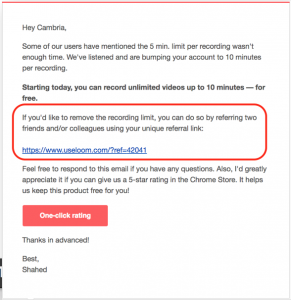 Referral email from Loom
Referral email from Loom
Zoom's free tier has a time limit on their group meetings, which wouldn't be ideal if you're a freelancer. Removing limits like this could be useful for freelancers.
Or you can offer a straight monetary incentive like Google does for their GSuite.
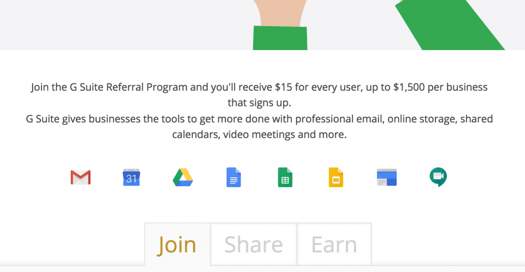 Google offers you that sweet cash for referrals
Google offers you that sweet cash for referrals
- Talk to other freelancers to figure out what the would be motivated by. With Zoom now capturing this data within the signup flow, they can segment that list and survey them.
Step 3: Deciding on the goal of your MVT
Like Zapier above the goal of the MVT would be sign ups. How many new sign ups would you get per freelancer over a certain period of time?
If the program becomes established you could measure it based on NATs, which would be new active teams when more than two people in a new company use Zoom in a given week. The purpose of the program is to introduce Zoom to new companies and get multiple people within that company using the product.
Step 4: Prioritize your ideas for the MVT
At this point, we should have identified some freelancers in our user base, and for the test, we would want to pick those who have clients and regularly do video calls with them.
If we haven't decided on the incentive, we could split them into cohorts, each with a different incentive in place. We would then look at, not only the number of new signups from each cohort, but also the cost to acquire those sign ups, either via the incentives Zoom give away or the straight fee.
Given we've collected information from freelancers as part of this test, we should be able to make an assumed guess at the number of meetings per week from each cohort and how long the MVT should be run in order for us to get enough data to decide if the program is working or not.
Step 5: Decide if you should scale the channel or look for other growth opportunities
At this point it's just a straight up choice, does this look worth investing time/effort/budget in comparison to other opportunities.
One long term bets for Zoom if the MVT proved successful is launching a review site for freelancers. It could help them to acquire a lot more traffic from search.
When on the site companies could both find their freelancer and automatically book a meeting with them via an embedded calendar that defaults to Zoom for the video call.
Credo is a review site for digital agencies and freelancers, you could imagine a 'Book Meeting Now' option being available
 How good are my design skills
How good are my design skills
Again you can apply each of those steps to the simple framework we introduced at the start of this post.
 Zoom MVT Experiment Framework
Zoom MVT Experiment Framework
Running MVT's for acquisition is one way you can discover leverage that your competitors may not have found yet.
It's also a great exercise to go through so you can keep your marketing brain sharp. No idea, no matter how whacky or seemingly impossible should be off the table. The craziest idea can often lead to something actionable.
Topics: Growth
